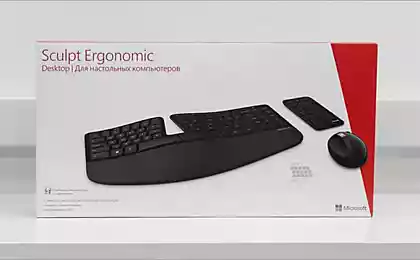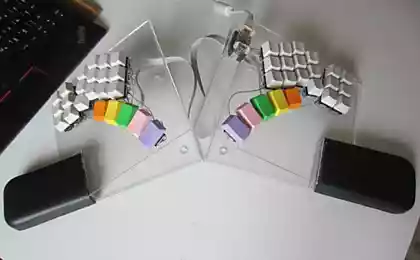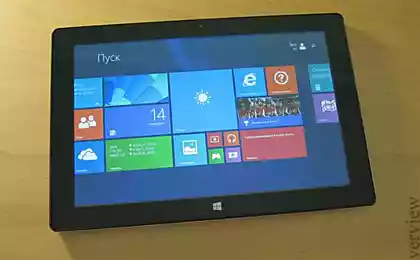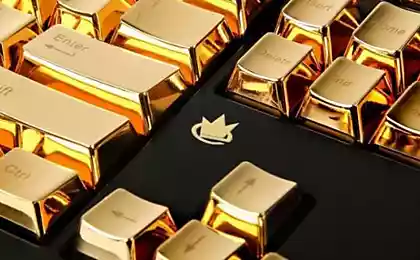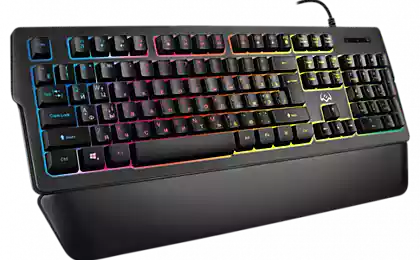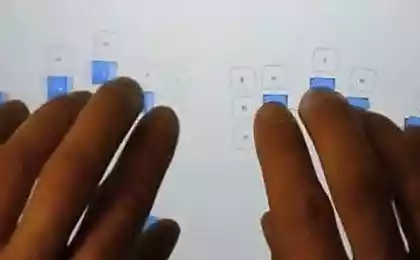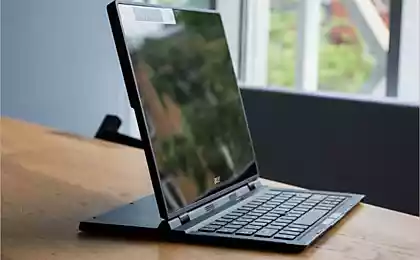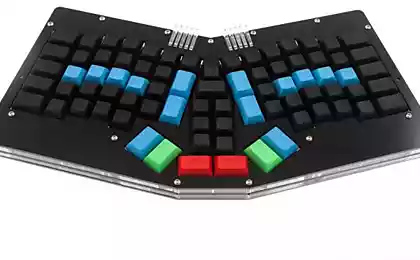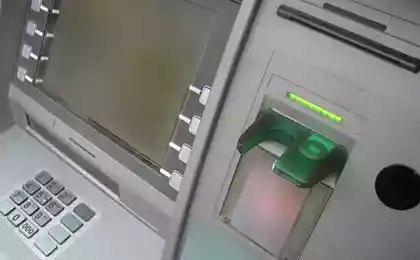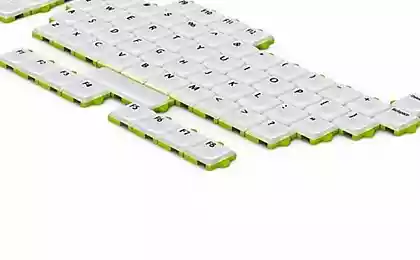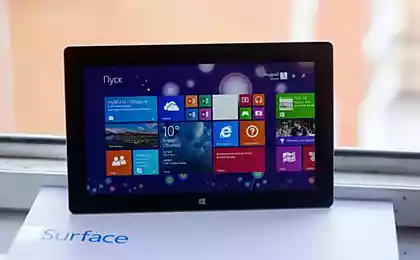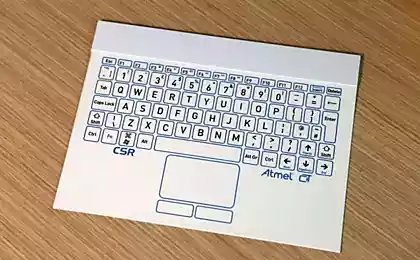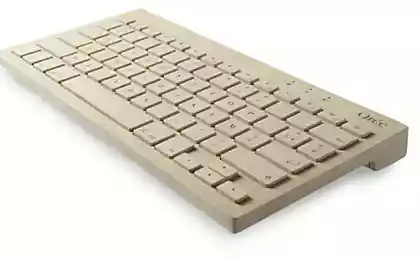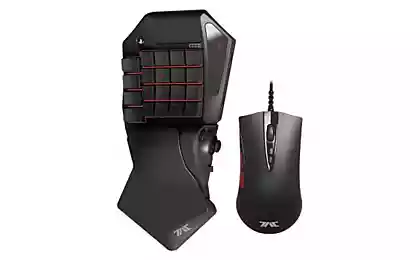1780
Keyboard as a piece of history
30 years her imitate, copy, modify - we are talking about IBM Model M, ancestor of modern design keyboard.
The first thing that catches your eye when you to get their hands on the keyboard IBM Model M, - is its size. After many years clatter on small buttons and screens, glass half-kilogram device, somewhat unusual to keep weight of about 2, 5 kg of metal and plastics (including thick steel plate). Second - it's the sound: loud click, turning a standard beige peripheral device in one of the most valuable and useful antiquities of the computer world.
The following year, Model M turns 30 years old. But many people still appreciate it above all others.
8 photos.

Recently, it was noticed on the table Minecraft creator Markus "Notch" Persson - it was connected to the PC game, one card is worth, perhaps, more than one thousand dollars. «Model M, in fact, the best keyboard of all time" - he said in an interview. Lined with dozens on YouTube demo recruitment for Model M, the video with the process of unpacking and comparing its sound with the sound of other mechanical keyboards. Since its inception, Model M is a model of an ideal keyboard.
"I like the iPad, this wonderful device; Reader Kindle - a wonderful thing - says Brandon Ermita, IT-manager at Princeton University - but I would never have written a single article or a thesis or other work using the touch screen. " Ermita lot of time to extend the life of Model M: he takes them from the warehouses and recyclables collection point, sells them on his website ClickyKeyboards and directs this private museum Model M. He estimated that over the last ten years he was able to pass into the hands of the fans of this keyboard 4,000 to 5,000 copies.
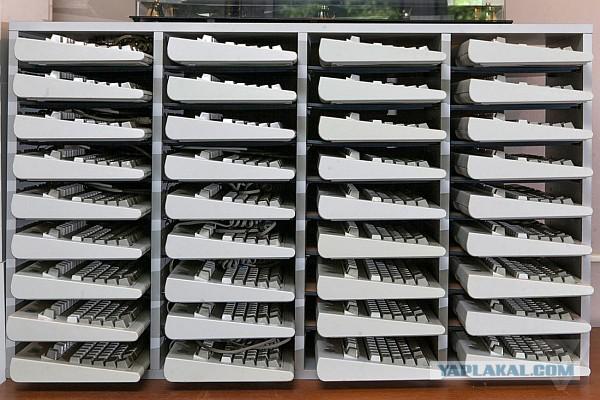
Like many others, we have remained a vague memory of former childhood Model M. Yet last month we went to the suburbs of New Jersey to meet with Hermite and rediscover the magic of one of the most popular keyboards of all time.
On the day of our visit in his spacious office about two dozen keyboards gently lay on a shelf, like expensive wines. Above them in a protective glass case separately lay black keyboard - Prototype Model M, one of the oldest objects in the collection of Ermita. In a large basket lying recent acquisitions that have had to sort out and clear the chips, sewing needles and other debris left over from the previous owners. Seeing Model M for the first time in many years, the most notable aspect for us was its unremarkable appearance. Perhaps, Model M and a relic of the past, but its DNA can be found in almost any modern keyboard.
Keyboards 70s and 80s were very different from the familiar to the paradoxical and totally unnatural.
QWERTY keyboard was invented in the late 19th century for typists and quickly became the accepted standard. But by the time of release in 1981 of the first IBM computer layout included not just the key to set capital letters and spaces - modern users already experienced word processors, terminals and "calculators". Looking back, you realize that the keyboard 1970 and 1980 were very different from the familiar to the paradoxical and totally unnatural. For example, in the original 83-key keyboard for IBM PC, known as the PC / XT, the most important down the Shift key and Return were small in size and shifted somewhere to the side, besides they were marked with cryptic arrows. In general, it gave the impression of a chaotic set of miniature keys and strange gaps between them.

In August 1984, IBM announced the release of a much more attractive keyboard PC / AT. Compared with the previous model, "Keyboard PC / AT - it is a huge leap forward" - said in the magazine PC Magazine. AT is not like a modern keyboard: function keys in it arranged in two rows on the left instead of the usual one row at the top, Escape it hid among the auxiliary numeric keypad, and the Ctrl and Caps Lock swapped. But even in this form it is much more understandable to modern user than the previous one.

But at IBM wanted to create something more than just a viable option. In early 1980, the company collected task force of 10 people and with the task to create a better keyboard, based on the recommendations of experts and users. Design a previous version was made "quickly, quickly - can not say that it was the result of serious teamwork," - says David Bradley, a member of the Task Force, the merit of which, among other things, is to create a common nowadays function Ctrl + Alt + Delete. A new group of novice computer users invited to test a more comfortable keyboard, in which the important keys were made larger, and often used - such as Ctrl and Alt - installed in two places, so to them it was easy to reach with either hand. Many key if desired, can be removed and rearranged to another place. Thus was born the Model M.
In 1985, the Model M was introduced as part of the IBM 3161 terminal and was named "Enhanced Keyboard IBM». Compatible with PC version was released the following spring, and in 1987 it became an official standard for the IBM Personal System / 2. The earliest Model M, according to Ermita - this version of the terminal produced by 10 June 1985.

So accurately determine the date of possible thanks to the fact that on the back of each Model M keyboard stands a unique identification number and date of manufacture - to Hermite constantly receiving orders from those over 20, to find the keyboard made in their birthday. He also leads Model M Archive Project, a huge archive of spreadsheets, which contain information on all keyboards that have passed through his company, as well as those information (identification number, date of manufacture and serial number) which are provided by other users.
I have a vague feeling that IBM said to me: "You should love it because it is the keyboard of the future," - writes columnist for the magazine PC Magazine.
Collection Hermite includes many specific, narrow-profile keyboards, such as keys with names intended for ordering at a travel agency, or a small model, in which the keys are grouped according to the three together - perhaps for cashiers. "When computers are just entering the market, they are positioned as a business device," - says Neil Muyskens, former manager of IBM. On older keyboards are still preserved stickers teams for specific programs, and observers estimate put keyboards in part, based on how well they are suited for use with programs such as WordStar and Lotus 1-2-3.
One reviewer upset that in Model M has once again changed the location of the keys, but at the same time not feeling that this design is here to stay. I have a vague feeling that IBM said to me: "You should love it because it is the keyboard of the future" - wrote a columnist for the magazine PC Magazine - and, as shown by the further development of computer technology, it was, to put it mildly, more than a true premonition .
That layout Model M has not changed for so long that there is simply perceived as something self-evident. But the descendants of the keyboard has been left behind one of the most legendary "chips» Model M: keys bending spring - mechanism, which appeared in PC / XT. Unlike mechanical switches that are pressed vertically, like a piston, a Model M under each key was a spring that is compressed, flattened or bent, and then, when the key is released, bouncing back. In contrast to the soft, quiet rubber caps used in most modern keyboards, they attracted attention. And it's not always a good thing: the owners of Model M from time to time publish stories that complain that their spouses or colleagues can not stand the continuous knocking. But connoisseurs say that the resistance of the springs and their loud "click" help us to understand whether to end the key is pressed, which in turn reduces the number of errors. And that, perhaps, more importantly, typing on a Model M - it's something special, tangible. Much like a typewriter, a distinct click allows physically feel each letter.
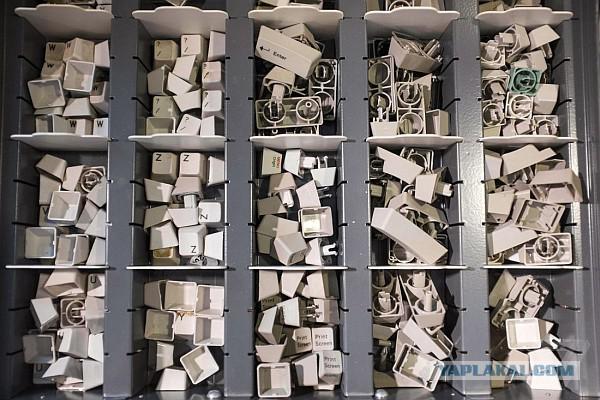
Soon after the Model M, appeared on the market a lot of her twins. For its part, IBM has contributed to the design of their new models of keyboards only token changes. As a result, the nostalgia for the Model M is transmitted from generation to generation. "People often contact me by e-mail to thank for the fact that I reminded them times when in the 1980s they were young engineering students," - says Ermita. Younger buyers remember how in school, they joked about his classmates, rearranging them on the keyboard ».
In 1990, IBM has transformed its direction for the production in the United States typewriters, keyboards and printers in a new company called Lexmark. Six years later, Lexmark abandoned manufacturing keyboards - it happened during that Myuskens calls general transition the industry to manufacture cheaper goods. IBM continued to order them at the factory in Scotland and some time in the company called Maxi-Switch, but as far as we know, the latest IBM Model M came off the assembly line in 1999.
With such a limited supply fans will soon lose the opportunity to Model M typing on your favorite keyboard.
For about $ 80 the official version of Model M can buy now, but it will not be the brand IBM. After Lexmark departed from cases Myuskens along with other former employees of the company under the guise of Unicomp gradually began to acquire patents and equipment for the production of this keyboard. "We had to change the electronics, - says Myuskens - Material hinged shelves changed back in 1999. But almost everything else remains the same."

For some, it is still insufficient. "We were constantly asked if we could sell the product with the logo IBM? We answer that no logo is owned by IBM, »- says Myuskens. He says that IBM is still a small amount of orders keyboards for its existing commercial customers, but if you need the old logo, will have to turn to eBay or to people like Ermita. For others, the inherent Model M excellent quality and variety of important nostalgic notions of authenticity: some users rework them into a wireless Bluetooth-enabled devices. One user posted Reddit original modification backlit keys that reminded stunning design Razer or Alienware. But with such a limited supply fans will soon lose the opportunity to Model M typing on your favorite keyboard.
"This can be compared with the oil. Once the oil reserves are exhausted. And it will be a disaster, "- says Ermita. But now it seems that this is still very far away. The oldest Model M has already served 30 years, and Hermite hopes that they will stretch another 10 years or 20 - enough to make at least one more generation could he borrowed a part of computer history.
Model M - an artifact of the time when the latest computing systems are designed mainly for industrial use, and not for entertainment. Computer PS / 2, for which it was designed, was worth at least $ 2,295 (by today's standards it's about $ 5000), and its power and functionality far inferior to any modern smartphone. Decades later, the power of computers has grown exponentially, and their prices have fallen dramatically. But at the same producers rejected the concept of durability and long life: in an environment where many third-party companies are ready to sell the latest mouse and keyboard almost at cost, it is difficult to convince producers to invest the amount in excess of the minimum required.
And this rapid change of old technology with new gave us the opportunity to fully experience what we have lost, and awakened a passion for the instrument, which can both be admired and pounding without interruption. As stated in a recent comment on Reddit, «These erundoviny - Real gaming keyboard. How would you scoffed at her, she was still outlive you. "Source
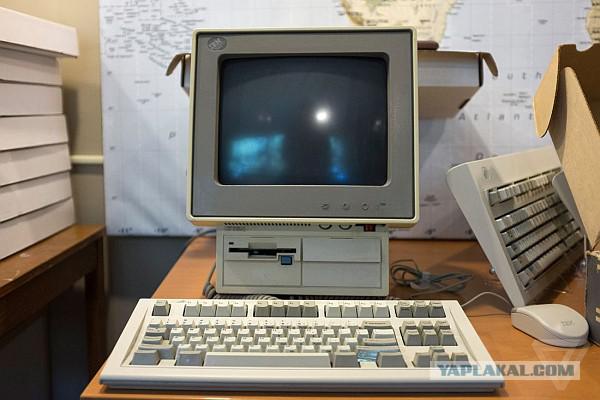
The first thing that catches your eye when you to get their hands on the keyboard IBM Model M, - is its size. After many years clatter on small buttons and screens, glass half-kilogram device, somewhat unusual to keep weight of about 2, 5 kg of metal and plastics (including thick steel plate). Second - it's the sound: loud click, turning a standard beige peripheral device in one of the most valuable and useful antiquities of the computer world.
The following year, Model M turns 30 years old. But many people still appreciate it above all others.
8 photos.

Recently, it was noticed on the table Minecraft creator Markus "Notch" Persson - it was connected to the PC game, one card is worth, perhaps, more than one thousand dollars. «Model M, in fact, the best keyboard of all time" - he said in an interview. Lined with dozens on YouTube demo recruitment for Model M, the video with the process of unpacking and comparing its sound with the sound of other mechanical keyboards. Since its inception, Model M is a model of an ideal keyboard.
"I like the iPad, this wonderful device; Reader Kindle - a wonderful thing - says Brandon Ermita, IT-manager at Princeton University - but I would never have written a single article or a thesis or other work using the touch screen. " Ermita lot of time to extend the life of Model M: he takes them from the warehouses and recyclables collection point, sells them on his website ClickyKeyboards and directs this private museum Model M. He estimated that over the last ten years he was able to pass into the hands of the fans of this keyboard 4,000 to 5,000 copies.

Like many others, we have remained a vague memory of former childhood Model M. Yet last month we went to the suburbs of New Jersey to meet with Hermite and rediscover the magic of one of the most popular keyboards of all time.
On the day of our visit in his spacious office about two dozen keyboards gently lay on a shelf, like expensive wines. Above them in a protective glass case separately lay black keyboard - Prototype Model M, one of the oldest objects in the collection of Ermita. In a large basket lying recent acquisitions that have had to sort out and clear the chips, sewing needles and other debris left over from the previous owners. Seeing Model M for the first time in many years, the most notable aspect for us was its unremarkable appearance. Perhaps, Model M and a relic of the past, but its DNA can be found in almost any modern keyboard.
Keyboards 70s and 80s were very different from the familiar to the paradoxical and totally unnatural.
QWERTY keyboard was invented in the late 19th century for typists and quickly became the accepted standard. But by the time of release in 1981 of the first IBM computer layout included not just the key to set capital letters and spaces - modern users already experienced word processors, terminals and "calculators". Looking back, you realize that the keyboard 1970 and 1980 were very different from the familiar to the paradoxical and totally unnatural. For example, in the original 83-key keyboard for IBM PC, known as the PC / XT, the most important down the Shift key and Return were small in size and shifted somewhere to the side, besides they were marked with cryptic arrows. In general, it gave the impression of a chaotic set of miniature keys and strange gaps between them.

In August 1984, IBM announced the release of a much more attractive keyboard PC / AT. Compared with the previous model, "Keyboard PC / AT - it is a huge leap forward" - said in the magazine PC Magazine. AT is not like a modern keyboard: function keys in it arranged in two rows on the left instead of the usual one row at the top, Escape it hid among the auxiliary numeric keypad, and the Ctrl and Caps Lock swapped. But even in this form it is much more understandable to modern user than the previous one.

But at IBM wanted to create something more than just a viable option. In early 1980, the company collected task force of 10 people and with the task to create a better keyboard, based on the recommendations of experts and users. Design a previous version was made "quickly, quickly - can not say that it was the result of serious teamwork," - says David Bradley, a member of the Task Force, the merit of which, among other things, is to create a common nowadays function Ctrl + Alt + Delete. A new group of novice computer users invited to test a more comfortable keyboard, in which the important keys were made larger, and often used - such as Ctrl and Alt - installed in two places, so to them it was easy to reach with either hand. Many key if desired, can be removed and rearranged to another place. Thus was born the Model M.
In 1985, the Model M was introduced as part of the IBM 3161 terminal and was named "Enhanced Keyboard IBM». Compatible with PC version was released the following spring, and in 1987 it became an official standard for the IBM Personal System / 2. The earliest Model M, according to Ermita - this version of the terminal produced by 10 June 1985.

So accurately determine the date of possible thanks to the fact that on the back of each Model M keyboard stands a unique identification number and date of manufacture - to Hermite constantly receiving orders from those over 20, to find the keyboard made in their birthday. He also leads Model M Archive Project, a huge archive of spreadsheets, which contain information on all keyboards that have passed through his company, as well as those information (identification number, date of manufacture and serial number) which are provided by other users.
I have a vague feeling that IBM said to me: "You should love it because it is the keyboard of the future," - writes columnist for the magazine PC Magazine.
Collection Hermite includes many specific, narrow-profile keyboards, such as keys with names intended for ordering at a travel agency, or a small model, in which the keys are grouped according to the three together - perhaps for cashiers. "When computers are just entering the market, they are positioned as a business device," - says Neil Muyskens, former manager of IBM. On older keyboards are still preserved stickers teams for specific programs, and observers estimate put keyboards in part, based on how well they are suited for use with programs such as WordStar and Lotus 1-2-3.
One reviewer upset that in Model M has once again changed the location of the keys, but at the same time not feeling that this design is here to stay. I have a vague feeling that IBM said to me: "You should love it because it is the keyboard of the future" - wrote a columnist for the magazine PC Magazine - and, as shown by the further development of computer technology, it was, to put it mildly, more than a true premonition .
That layout Model M has not changed for so long that there is simply perceived as something self-evident. But the descendants of the keyboard has been left behind one of the most legendary "chips» Model M: keys bending spring - mechanism, which appeared in PC / XT. Unlike mechanical switches that are pressed vertically, like a piston, a Model M under each key was a spring that is compressed, flattened or bent, and then, when the key is released, bouncing back. In contrast to the soft, quiet rubber caps used in most modern keyboards, they attracted attention. And it's not always a good thing: the owners of Model M from time to time publish stories that complain that their spouses or colleagues can not stand the continuous knocking. But connoisseurs say that the resistance of the springs and their loud "click" help us to understand whether to end the key is pressed, which in turn reduces the number of errors. And that, perhaps, more importantly, typing on a Model M - it's something special, tangible. Much like a typewriter, a distinct click allows physically feel each letter.

Soon after the Model M, appeared on the market a lot of her twins. For its part, IBM has contributed to the design of their new models of keyboards only token changes. As a result, the nostalgia for the Model M is transmitted from generation to generation. "People often contact me by e-mail to thank for the fact that I reminded them times when in the 1980s they were young engineering students," - says Ermita. Younger buyers remember how in school, they joked about his classmates, rearranging them on the keyboard ».
In 1990, IBM has transformed its direction for the production in the United States typewriters, keyboards and printers in a new company called Lexmark. Six years later, Lexmark abandoned manufacturing keyboards - it happened during that Myuskens calls general transition the industry to manufacture cheaper goods. IBM continued to order them at the factory in Scotland and some time in the company called Maxi-Switch, but as far as we know, the latest IBM Model M came off the assembly line in 1999.
With such a limited supply fans will soon lose the opportunity to Model M typing on your favorite keyboard.
For about $ 80 the official version of Model M can buy now, but it will not be the brand IBM. After Lexmark departed from cases Myuskens along with other former employees of the company under the guise of Unicomp gradually began to acquire patents and equipment for the production of this keyboard. "We had to change the electronics, - says Myuskens - Material hinged shelves changed back in 1999. But almost everything else remains the same."

For some, it is still insufficient. "We were constantly asked if we could sell the product with the logo IBM? We answer that no logo is owned by IBM, »- says Myuskens. He says that IBM is still a small amount of orders keyboards for its existing commercial customers, but if you need the old logo, will have to turn to eBay or to people like Ermita. For others, the inherent Model M excellent quality and variety of important nostalgic notions of authenticity: some users rework them into a wireless Bluetooth-enabled devices. One user posted Reddit original modification backlit keys that reminded stunning design Razer or Alienware. But with such a limited supply fans will soon lose the opportunity to Model M typing on your favorite keyboard.
"This can be compared with the oil. Once the oil reserves are exhausted. And it will be a disaster, "- says Ermita. But now it seems that this is still very far away. The oldest Model M has already served 30 years, and Hermite hopes that they will stretch another 10 years or 20 - enough to make at least one more generation could he borrowed a part of computer history.
Model M - an artifact of the time when the latest computing systems are designed mainly for industrial use, and not for entertainment. Computer PS / 2, for which it was designed, was worth at least $ 2,295 (by today's standards it's about $ 5000), and its power and functionality far inferior to any modern smartphone. Decades later, the power of computers has grown exponentially, and their prices have fallen dramatically. But at the same producers rejected the concept of durability and long life: in an environment where many third-party companies are ready to sell the latest mouse and keyboard almost at cost, it is difficult to convince producers to invest the amount in excess of the minimum required.
And this rapid change of old technology with new gave us the opportunity to fully experience what we have lost, and awakened a passion for the instrument, which can both be admired and pounding without interruption. As stated in a recent comment on Reddit, «These erundoviny - Real gaming keyboard. How would you scoffed at her, she was still outlive you. "Source

